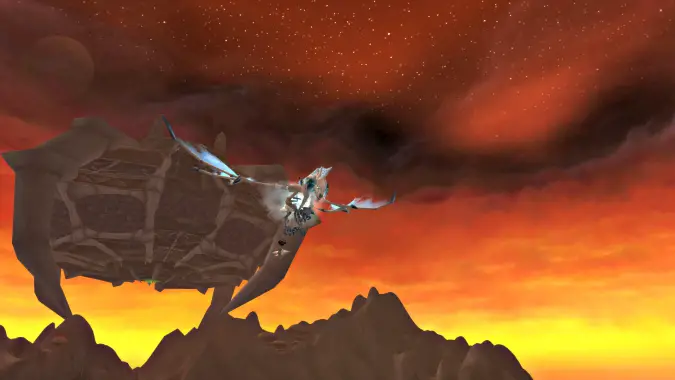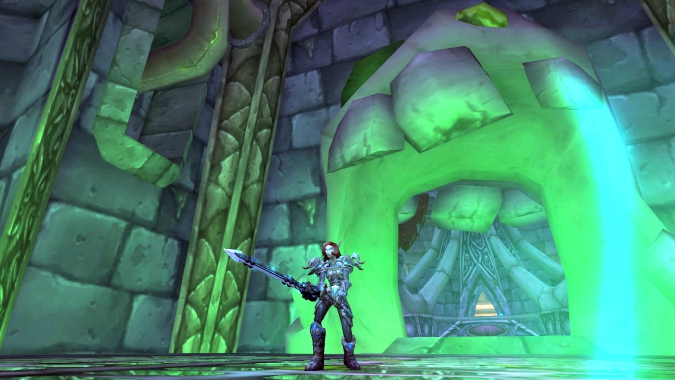Plaguebearer: Reminiscing on Death Knight fantasy and flavor

As the general lull in information about Legion continues, players are largely left to their own devices in attempting to piece together an analysis of what the expansion might bring. In terms of class changes, it’s been emphasized that Legion seeks to reexamine the core fantasy behind every class/spec in the game, and make changes to various classes based on the notion that this sense of fantasy has been diluted over the past several years, and should thus be corrected. With this in mind, what does one say about Death Knight fantasy nearly eight years after our class was launched (and presumably a full decade after conceptions of the class originally began)?
From the foundations
Over a year ago, I was asked to write the Death Knight section for the Warlords of Draenor strategy guide. When considering what to write for my brief class introduction, I eventually settled on the following opening paragraph about Death Knights: “These shadowy, immortal soldiers are former slaves of the Lich King, and fight with emblazoned Runeblades. They utilize a combination of melee strikes and dark magic to empower their abilities, also holding dominion over various undead creatures to do their bidding.”
When communicating the fantasy of Death Knights in a limited space, I tried to inspire an image that captured its essence well. For me, this meant the dark origins of the class — the ability of being able to play something “evil” theme-wise is a very huge pull-factor. Especially when that evil doesn’t come from being corrupted, but literally being forged in evil and then choosing to use that power another way. It’s also one reason why I believe DKs were so popular when they launched — and why Demon Hunters will be too.
What, then, makes our class different from a simple “evil Warrior/Paladin” archetype? Their specific dominion over magic, of course! Both the necromantic magic that allows Death Knights to raise legions of undead soldiers, and also the runic enchantments that allow them to empower themselves define a very distinct theme for the class. This was one reason behind why I believe the original incarnation of the Death Knight had so much pull: The existence of the old talent trees allowed developers to create dozens of evil-sounding talents, passives and abilities that truly enhanced the fearsome projection of the class that Blizzard wanted to put forward. It is also why I felt that the theme of the three Death Knight trees was very distinct, but also blended together well: The ability to morph from a Frost to an Unholy and then to a Blood Death Knight was simply a matter of choosing how your dark power manifested — the base essence still remained the same.
One of the most iconic scenes that screamed Death Knight to me was when the Lich King was chasing players in Halls of Reflection. He moved slowly, but came as an unstoppable wall of death, remorseless winter swirling around him, ghouls and undead erupting everywhere, and an encroaching sense of dread as he drew closer. Our class is thus not marked by being nimble or swift, but by slow purposefulness. Once a Death Knight manages to reach their target, they deliver unprecedented amounts of pain, not only to their unfortunate victim but to the very surroundings around them.
It’s all about runes
Now that we have the basis for identity defined, how does that translate into our actual in-game specializations and mechanics? All three Death Knight specializations are distinct, but share a similar resource system. This resource system, by itself, is something that helps differentiate the class from any of its counterparts in-game. When thinking about how to introduce new players to the rune system in the guide I mentioned above, I eventually settled with: “The Rune system is a resource structure unique to Death Knights. No other class in the game can be said to have a system that is similar or, arguably, more engaging. Mastery of the Rune system is a core component of learning how to play a Death Knight.” I also wanted to emphasize the importance of runes in terms of granting our weapons with special powers: “One of the perks of being a Death Knight is their ability to emblazon their weapons with powerful Runeforges. Runeforges are unique, and completely replace traditional weapon enchants for Death Knights.”
I see Mana, Energy, Rage and even class specific resources such as Holy Power as still being variations on one another at best. Runes, on the other hand, demand a level of attention to detail that I would assert other resource systems currently do not. If other classes are defined by paying attention to how/when they utilize their abilities, then I’d argue that Death Knights are currently defined by concentrating heavily on how they manage their resources, when they spend them and how their use of resources determines their ultimate outcome. The gameplay the rune system provides (both by itself and how it interacts with talents such as Plague Leech or Blood Tap) is a huge part of what makes Death Knights what they are.
Unfortunately, this also brings up a problem: World of Warcraft currently offers paid services such as high level boosts for players. The vision of a class that I’ve just laid out is quite decidedly something that is not boost friendly: Starting a DK right now assumes that a player understands game basics and is usually looking for something more challenging to try and tackle. Note that I’m not saying that the act of playing the class itself is more challenging compared to others, but that understanding the complexities behind the rune system can often act as a barrier for players wishing to experience it for the first time. Is there any solution that can reconcile these differences? I can’t say that I have a definitive answer to that question.

Spec identity and flavor
As I mentioned earlier, part of the fantasy of the class for me is the notion that DKs can change their style of play very easily thanks to the resource system uniting them. The trees themselves, however, are distinct from one another, as I’ll discuss below. As a forewarning, I’m going to ignore actual mechanical flaws and in-game shortcomings here, and delve into the actual theme behind each spec.
I see Blood Death Knights as being all about self-healing and vampiric powers, being able to use corrupted life energy as their form of mitigation. As far as other Tank specs go, what makes Blood unique is the large number of cooldowns it possesses. This is awesome, because the fantasy behind using short bursts of power to improve upon your standard rotation is something that’s present in multiple DPS classes, yet not as much among tanks (I’m not counting semi-rotational Active Mitigation abilities here).
Moving on, Frost Death Knights have always been about sudden burst damage. Whether it be AoE or single-target, the ability of a Frost Death Knight to rapidly deal massive crits and tear apart unprepared foes is what makes it its own spec. Despite how flawed Killing Machine is as a mechanic, the fantasy behind it delivers. The same also went for an ability in Wrath of the Lich King called Deathchill, which I recall often using to pair up with AoE burst. Howling Blast, Obliterate and Frost Strike are all very big parts of this, and the way in which they function relative to one another often determines whether I find playing my Frost DK satisfying or annoying.
Finally, we arrive at Unholy: The spec that first got me interested in playing a DK and also in theorycrafting. While I’ll admit that Blood has become a very big focus of mine due to how much soloing and Tank theorycraft I partake in, Unholy’s fantasy is still one of my favorites: In contrast to Frost’s “rapid damage delivery”, Unholy is all about slow rot and decay. I still have fond memories of Wrath of the Lich King days, when it dealt the highest magical damage out of all DK specs by far, and centered its ability on both its diseases and the undead minions it summoned. While I mentioned undead minions being a defining part of playing a DK, what made them special for Unholy was how highly specialized they were — things like the Gargoyle and empowering my ghoul felt like a cool way to split my damage into multiple components, compared to Frost’s more direct damage approach. To be clear, I see diseases as being a cool and important aspect of all DK specs — Unholy just has a special emphasis on them because its DoTs are innately more potent and more demanding of attention (hello Festerblight!) than other specs.
Where could we be going?
The ultimate question of “Where is Blizzard taking us?” is one that I don’t believe the player base should ask without fully reflecting on the journey we’ve undertaken to get where we are now. This doesn’t only include each spec’s journey in fantasy, but also how that’s been reflected with in-game design. Assuming no major Legion information goes public before BlizzCon, I intend for my next few columns to detail some of the journeys we as a class have undertaken thus far.
Until next time, suffer well brethren!
Please consider supporting our Patreon!
Join the Discussion
Blizzard Watch is a safe space for all readers. By leaving comments on this site you agree to follow our commenting and community guidelines.
 @MagdalenaDK
@MagdalenaDK





